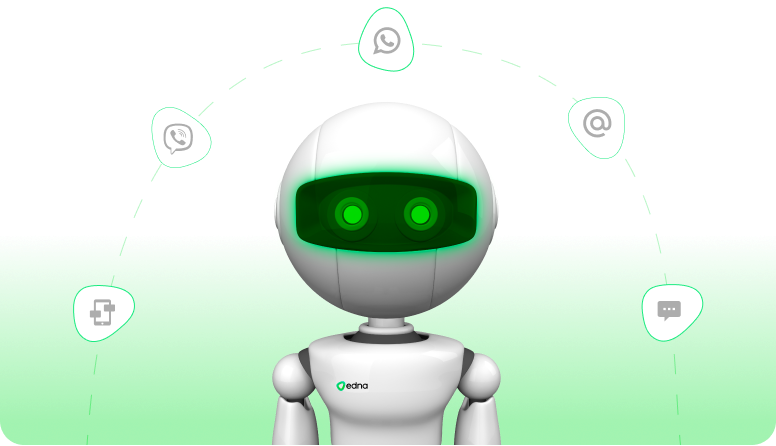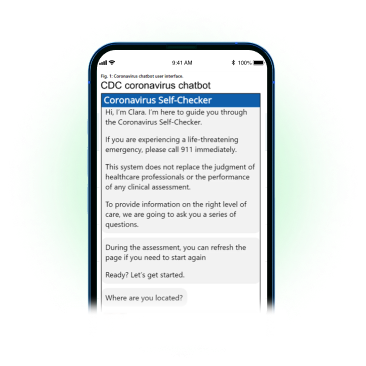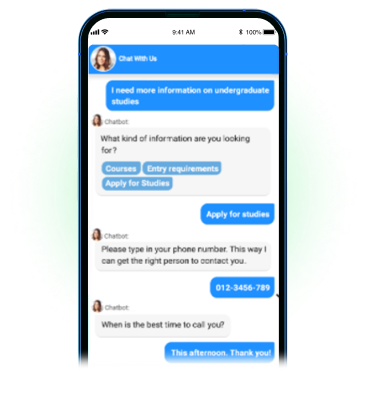Looking to Deploy Chatbots? Here’s All You Need to Know

Over the past few years, there has been a perceptible shift in the communication preferences of customers – they have increasingly turned to messaging to talk to businesses. Whether it is to order products online, update addresses, check the delivery status of products, or even register complaints, they prefer messaging over emails or phone calls simply because its more convenient. The growing use of chatbots has heralded this change. Chatbots are popular with customers as they meet their need for real-time responses, convenience, and ease of use.
Companies are aware of this shift in preferences and also of the incredible benefits bots bring from a business perspective – they save the company time and resources, provide 24*7 customer support, increase conversion rates, speed up the sales cycle, and solve customer issues easily. Companies use bots for industry-specific, pre-defined scenarios, such as to automate greeting messages, send out alerts, share FAQs, help users complete tasks, and so on. They can be integrated with existing platforms such as Facebook Messenger, chat centers, and WhatsApp to provide all-round support. Their ability to auto-tag incoming messages help companies segment their customers, who can then be targeted with personalized offers. So companies are going all out to make bots an integral part of their customer communication strategy.
| 67% Customers globally used a chatbot for customer support in the past one year Source: Invesp | 80% Routine queries can be answered by chatbots, speeding up response times Source: Invesp | 48% Customers prefer to chat with a bot that solves issues over a chatbot that has a personality Source: Business Insider |
| 57% Executives believe that conversational bots can deliver large returns on investment for minimal effort Source: Invesp |  | >50% Of enterprise companies are predicted to spend more money per annum on chatbot development than on mobile apps by 2021 Source: Gartner |
| 56% Customers prefer to chat with a business rather than call them Source: Outgrow | >300 000 Chatbots on Messenger currently Source: VentureBeat | 30% Reduction in customer support costs Source: Salesforce |
However, more often than not, businesses are unable to utilize bots to their fullest advantage. They invest heavily in automation and sophisticated chatbot AI capabilities, but still fail to achieve desirable results. If not used for the right purposes, or if implementation is faulty, bots can create frustration for customers and harm the brand. Having a well-thought-out strategy can prevent this from happening. We discuss a few things you need to keep in mind to get the most out of the chatbot technology. You could begin by asking yourselves these basic questions:
 What Types of Queries Do We Want to Automate?
What Types of Queries Do We Want to Automate?
Are They Suitable for Bots?
Customers prefer different touchpoints for different types of communication. For example, they may prefer messaging when they want to update their address, but opt for SMSs when it comes to receiving reminders. Businesses should conduct a thorough assessment of which queries customers prefer to have answered over messaging and focus on deploying bots to answer those queries.
 What Kind of Chatbot Would Best Suit Our Purposes?
What Kind of Chatbot Would Best Suit Our Purposes?
Many businesses dive headlong into deploying AI-driven bots, also known as virtual private assistants, which are “intelligent” and learn from every single interaction. They can improve the quality of their answers over time. However, building such bots is highly expensive as well as complicated. Any mistakes in execution can lead the bot to provide incorrect responses that can lead to a negative brand experience for customers. Also, many surveys reveal that customers prefer to chat with bots for simple queries and prefer a human agent for more complex ones. So for companies looking to deploy chats, it’s worth considering what you intend to use the bot for, and if at all a sophisticated bot needs to be used for it. Bots come in all varieties – from customer support bots, to lead gen bots, e-commerce bots, recruitment bots, and so on. Companies need to choose wisely as per their needs.
So, once these questions are sorted, you would do well to keep these things in mind:
1) Use Bots for Highly Repetitive, Less Complex Use Cases
When thinking of bots, we suggest businesses start with the ones that solve simple problems customers face on a day-to-day basis. Companies face repetitive queries from customers on a daily basis, for instance when customers want to schedule an appointment or request information about a particular product or service. Replying to such queries on phone or email requires companies to maintain a huge customer support team. What’s more, customers who call are put on hold for a long time, as a customer support agent can’t handle more than one call at a time. This clogs up the support pipeline and creates frustration for customers. Companies can start with automating such repetitive queries that can be easily solved in a menu-driven way that customers find easy to navigate.
2) Choose Your Bot Wisely
Not all bots are made the same. Many companies do not need to invest in AI-driven intelligent bots and can instead use simple rules-based bots that are task specific. These bots are not equipped to analyze queries or customer intent, or answer questions out of the defined rules. They pose simple questions to customers in the form of pre-decided options that customers can choose from to arrive at the answer they are looking for. A great advantage of such bots is that a good user experience is guaranteed as they are highly predictable. They are especially suitable for companies that want to deploy chatbots as an FAQ source or help users complete simple tasks by simply selecting from the menu options. A good example is a rules-based bot that helps customers order food online. The conversation flow is preset — the chatbot poses questions from a template, allows users to make the selection, confirms the order and shares payment links. The whole process only requires customers to click through to complete their orders.

3) Deploy Bots That Are Easy to Set Up
Rules-based bots are more accessible for brands as they are very easy to set up. They can be quickly set up, are easy to control, and can be applied to a wide variety of business use cases. They don’t require complicated coding by developers or help from agencies. Once the best chatbot use cases are determined, non-technical users simply need to choose the most appropriate conversation design platform from a host of available options and map predetermined dialogue flows based on relevant cases. Platforms such as those offered by edna can be customized according to prebuilt chatbot templates that are industry-specific. They come with a simple drag-and-drop interface, where users can build automated conversations with no absolutely no coding requirements.
4) Use a Bot That Can Be Optimized for Multiple Channels
Customers typically use more than one touchpoint when they want to get in touch with businesses. So it makes sense for companies to deploy bots on multiple mediums – for instance, not just on live web chat, but also chatbots on WhatsApp, Facebook Messenger, Instagram, Apple Business Chat, and more. However, managing bots across multiple channels can create fragmented experiences as bots might behave differently on different interfaces – say interaction on WhatsApp vs In-App chat. So it’s vital for companies to coordinate the interactions across platforms and ensure a similar experience for users. A lack of channel cohesion can leave a customer with a bad omnichannel experience, sometimes putting them off digital channels altogether.

The best way out for companies is to build a single bot and optimize it across multiple channels. Platforms like edna can easily handle channel-specific response formats. edna’s bots come with universal usability. Once you have customized and trained the bots, you can deploy them across multiple platforms such as live chat on web and app as well as on various social messengers. Once deployed, the bot can be continuously trained by your contact center agents for more personalized customer communication. You can also choose to differentiate responses across messaging platforms or use channel-specific interface elements.
Industries Seeing an Uptake in Bot Usage
While bots have been popular for quite some time in industries like banking and e-commerce, the covid-19 pandemic has increased the demand for bots even among industries that had traditionally been reluctant to use digital interfaces. Key among them are healthcare, education, and food service industries.
Healthcare: The covid-19 pandemic has brought to the fore the need for virtualized healthcare. Many healthcare providers started turning to chatbots to provide a host of healthcare services. These include:
- Scheduling appointments
- Sharing health tips on managing diseases
- Ordering medicines online

Food Services: Restaurant closures due to social distancing have resulted in an explosive growth in online ordering – for many restaurants, 90 percent of the revenue now comes from online ordering. This new normal has made chatbots an incredible tool for businesses looking to add efficiency to their customer interactions. They can reach out to a wider audience on different channels like Facebook Messenger or WhatsApp.
Bots can provide a number of services including:
- Sharing menu options and taking orders
- Offering limited time deals and discounts
- Sharing menu options and taking orders
- Offering limited time deals and discounts
Education: With schools temporarily closed and students moving to virtualized classes, the use of learning chatbots in education has become widespread. Many educational institutions are deploying simple bots with a database of questions that students can find answers to simply by clicking the menu options.
Bots can provide a number of services including:
- Sharing list of courses available, syllabus, and class timetables
- Sharing information like registration process, fee, deadlines
- Providing alerts like upcoming examinations, etc.





![[photo]](https://edna.io/wp-content/themes/edna/images/authors/paula-s.jpg)
![[icon]](https://edna.io/wp-content/themes/edna/images/authors/ico-linkedin.svg)